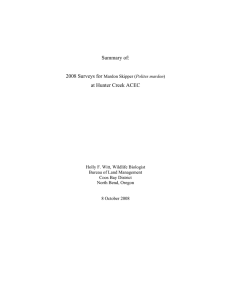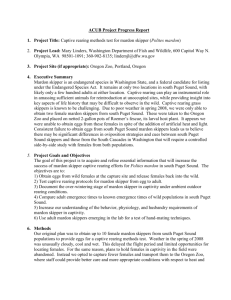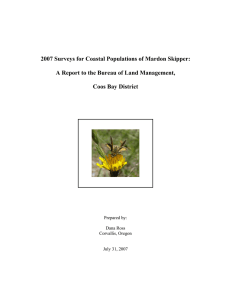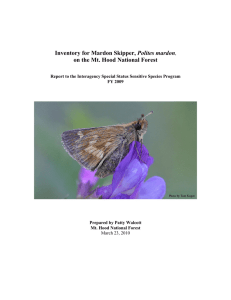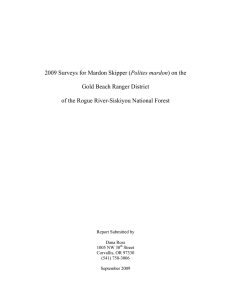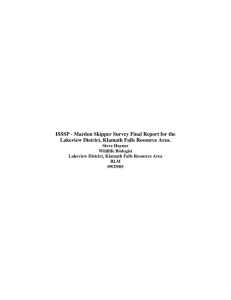Report to the U.S. Forest Service Polites mardon mardon
advertisement
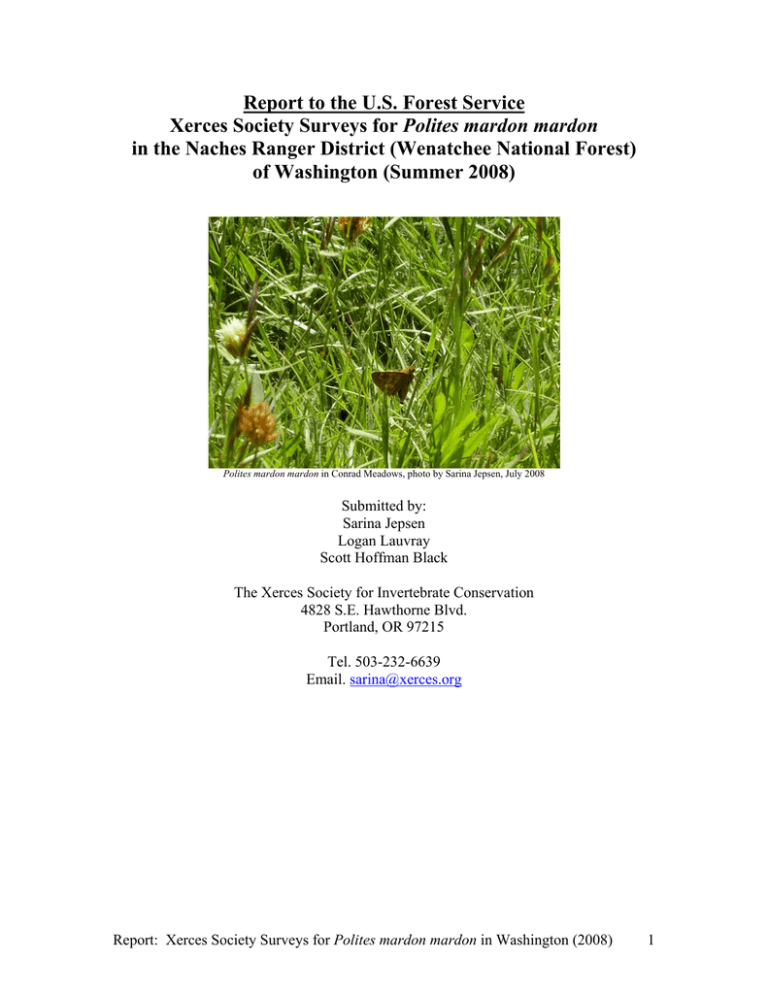
Report to the U.S. Forest Service Xerces Society Surveys for Polites mardon mardon in the Naches Ranger District (Wenatchee National Forest) of Washington (Summer 2008) Polites mardon mardon in Conrad Meadows, photo by Sarina Jepsen, July 2008 Submitted by: Sarina Jepsen Logan Lauvray Scott Hoffman Black The Xerces Society for Invertebrate Conservation 4828 S.E. Hawthorne Blvd. Portland, OR 97215 Tel. 503-232-6639 Email. sarina@xerces.org Report: Xerces Society Surveys for Polites mardon mardon in Washington (2008) 1 TABLE OF CONTENTS Table of Contents………………………………………………………………… 2 Executive Summary………………………………………………………………2 Introduction………………………………………………………………………. 2 Survey protocol…………….…………………………………………………….. 4 Summary of surveys at Minnie and Conrad meadows…………………………… 5 Summary of searches for new sites…….……………………………………….... 7 Additional work…………………………………………………………………... 12 Literature Cited……………….………………………...………………………… 12 Acknowledgements…………………………………………...………………….. 13 EXECUTIVE SUMMARY Xerces Society staff spent six days in June and July of 2008 studying Mardon skippers (Polites mardon mardon) in the Naches Ranger District of Washington State. Joan St. Hilaire (USFS), Bernie Bernatowitz (WDFW), Will Moore (WDFW), Ann Potter (WDFW), Erica Henry (graduate student, Washington State University), and Kelli VanNorman (BLM) participated in the survey effort. Erica Henry and Ann Potter also observed a number of female Mardon skippers ovipositing at three sites. The purpose of the 2008 survey effort was twofold: 1) to characterize the flight period and population sizes of two existing Mardon skipper sites by monitoring on three dates during the adult flight period of the butterfly, and 2) to locate new populations of Mardon skippers in the Naches Ranger District. We observed Mardon skipper adults at Conrad meadows and Minnie meadows on three dates, approximately one week apart, from June 24-July 9. At Minnie meadows, the flight period appeared to peak on June 30, 2008, when 187 individuals were observed in a oneday count. At Conrad meadows, the flight period appeared to peak on July 9, 2008, when 1,840 individuals were observed in a one-day count. Xerces staff and staff from the USFS and WDFW found seven new Mardon skipper sites in the Naches Ranger District in 2008. In this report, we provide a summary of our observations at Minnie and Conrad meadows, a list of all sites visited, and descriptive information for each of the Mardon skipper sites that were discovered in 2008. Note: A number of additional new Mardon skipper sites were discovered by Joan St. Hilaire and Bernie Bernatowitz; only the sites that were visited by Xerces staff are detailed in this report. INTRODUCTION The Mardon skipper (Polites mardon) is a small, tawny-orange butterfly (20-24 mm) with a stout body. It is distinguishable in the field from other similar skippers by a diagnostic pattern of rectangular white spots visible on the ventral hind wings of males and females males (Pyle 2002) and the shape of the stigma on dorsal forewings of males. Mardon skippers are currently found in the following disjunct areas: low elevation Report: Xerces Society Surveys for Polites mardon mardon in Washington (2008) 2 meadows of the coast range of coastal northern California and southern Oregon, prairies of the South Puget Sound in Washington State, and grasslands between roughly 500 and 1700 meters in the Cascade Mountain Range of Washington (around and northeast of Mt. Adams) and southern Oregon (east of Ashland). Most sites are relatively small, and support populations of less than 50 individuals. However, there are a number of more robust sites that maintain populations of hundreds of individuals, and one site that supports more than one thousand individuals in the Naches Ranger District. The Mardon skipper is listed as a federal candidate species under the U.S. Endangered Species Act and is listed as endangered in the state of Washington (Black & Vaughan 2005). Polites mardon use more than one graminoid species for oviposition. In Washington, the most common oviposition plants are Festuca idahoensis and Carex species (Beyer & Black 2007). In 2007 and 2008, P. mardon mardon appeared to be strongly associated with Danthonia unispicata at many sites in the Naches Ranger District and females were observed ovipositing on this plant (E. Henry, personal communication). Oviposition studies have not been conducted in California, but Festuca idahoensis is abundant at the known California Mardon skipper sites (Haggard 2003). In addition, Polites mardon seem to use a variety of nectar flower species. The most common observations were on Vicia species (Washington sites) and Potentilla diversifolia (Oregon sites). Many of the Mardon skipper habitats are subject to a variety of anthropogenic disturbances such as recreation, overgrazing, introduction of noxious weeds, various insecticides including Btk1 as well as natural succession (i.e., conifer encroachment on meadows) which may threaten persistence of individual sites. Little genetic exchange between populations may contribute to possible inbreeding. Mardon skippers are assumed to have limited dispersal (Runquist 2004), though long term studies are necessary to determine the effects of climatic and other variables on dispersal and annual reproductive success. Lack of genetic interchange and migration or dispersal between populations may make it impossible for an extirpated population to become reestablished. Taxonomy The Mardon skipper (Polites mardon) is in the family Hesperiidae (skippers) and the subfamily Hesperiinae (grass skippers). It was first described by W. H. Edwards (1881) from specimens taken near Tenino, Thurston County, Washington by H. K. Morrison (Dornfeld 1980). Mattoon et al. (1998) proposed that the Oregon population be given subspecies status Polites mardon klamathensis and that the Washington and California populations be considered Polites mardon mardon. Adults of P. m. klamathensis have a consistently tawnier dorsal and ventral coloration, when compared to adults from other populations (Warren 2005). A group of P. mardon populations exists in coastal Del Norte County approximately 80 air miles to the west of P. m. klamathensis populations. However the series of P. mardon from Del Norte County populations have not yet been carefully compared to series of P. mardon mardon from Washington and the use of the name P. mardon mardon for California populations should be considered tentative (Warren 2005). SURVEY PROTOCOL 1 Bacillus thuringiensis var kurstaki is a lepidopteran-specific insecticide Report: Xerces Society Surveys for Polites mardon mardon in Washington (2008) 3 Unless otherwise stated, all sites were surveyed during the following environmental conditions: Minimum temperature: Above 60 degrees Fahrenheit. Cloud cover: Partly sunny or better. On cooler days, the sun can play a very important role in getting butterflies to take to the air. On warmer days (above 60 degrees F), direct sunlight is less important, but a significant amount of the sun’s energy should be coming through the clouds to help elevate the temperature of basking butterflies. Wind: Less than 10 MPH. On windy days, butterflies will drop out of the air if they cannot maintain their direction and/or speed of flight. On days that were predominately calm, the wind occasionally will pick up. When surveys were conducted under these conditions, the surveyors would stop counting butterflies when it became windy and wait until the winds die down to resume the count. Time of year: All sites were visited between June 24 and July 10, 2008. To conduct one-day counts at known Mardon skipper sites, we followed this protocol: 1. We entered the sites and walked through it slowly (about 5 minutes to walk 100 meters), looking back and forth on either side, approximately 20 to 30 feet out. We did our best to walk in a path such that we covered the entire site with this visual field, or at least all of the areas of apparently suitable habitat. 2. When a suspected Mardon skipper butterfly was encountered, the butterfly was netted to confirm its identification. This is especially important because of its similarity to the Sonoran skipper Polites sonora, which also occurs at many sites supporting Mardon skippers. 3. Once a Mardon skipper sighting was confirmed, observers stood at the edge of the site, approximately 5 meters apart, and walked through the site. Observers counted each Mardon skipper that was observed in front and to the sides of the observer, communicating with the person on the left and right to make sure an individual butterfly was not counted twice. Mardon skippers flying behind the observers were not counted. Large sites took multiple passes in order to cover the entire site; observers stopped to record numbers after each pass was completed. In large sites, flagging was used to mark the path that is walked, so that the observers do not count Mardon skippers in the same area twice. 4. Record all data for sites whether butterflies are seen or not. In this way, we document both new sites where P. mardon is found, as well as our overall search effort. To identify new Mardon skipper sites, we followed this protocol: 1. We approach the site and scan for any butterfly activity, as well as suitable habitat. 2. We filled out all of the site information on datasheet. 3. We gave closer attention to wetter areas first. Mardon skippers seem to prefer Report: Xerces Society Surveys for Polites mardon mardon in Washington (2008) 4 4. 5. 6. 7. habitat close to small streams or other seasonally wet features. We walked through the site slowly (about 5 minutes to walk 100 meters), looking back and forth on either side, approximately 20 to 30 feet out. We did our best to walk in a path such that we covered the entire site with this visual field, or at least all of the areas of apparently suitable habitat. If we left our path to look at a particular butterfly, we did our best to return to the path when we resumed walking/searching through the site. When a suspected Mardon skipper butterfly was encountered, we netted the butterfly to confirm its identification. This is especially important because of its similarity to the Sonoran skipper Polites sonora, which also occurs at many sites supporting Mardon skippers. We recorded all data for sites whether butterflies are seen or not. In this way, we document both new sites where P. mardon is found, as well as our overall search effort. SUMMARY OF SURVEYS AT MINNIE AND CONRAD MEADOWS The main goals of monitoring Minnie and Conrad meadows during the 2008 field season were to: 1) better characterize the flight period for two populations of Mardon skippers in the Naches Ranger District and 2) gain a better understanding of the number of Mardon skippers that exist at these two sites. Minnie meadows At Minnie meadows, we counted Mardon skippers on June 24, June 30 and July 9 of 2008 (see Table 1). We kept track of how many individual skippers were counted within the elk and cattle exclosure (approximately 15 meters x 15 meters), within the cattle exclosure (approximately 15 meters x 15 meters), and in the rest of the meadow that was studied (at least ten times the size of the area within each exclosure; see Appendix A for the area studied). On June 24, mostly fresh males were observed, many of which were seen near wet areas of the meadow. On June 30, both males and females were observed, and oviposition behavior was noted. A male voucher specimen was taken on June 30 by Bernie Bernatowitz. On July 9, both male and female Mardon skippers were observed at this site, although there were many fewer than the previous week. We believe that the peak of the flight period was around June 30, since 52 Mardon skippers were observed on June 24, 187 were observed on June 30, and 51 were observed on July 9. We observed a higher diversity of flowering plants that Mardon skippers were using for nectar within the elk and cattle exclosure, although we still observed many Mardon skippers utilizing areas of the meadow outside of the exclosures. This year, the fence around the entire meadow has been repaired in an effort to effectively exclude cattle from the whole meadow. There has been a fence present in the past, but it was reportedly ineffective in excluding cattle from the meadow. Table 1. One day counts at Minnie meadows on 6/24/08, 6/30/08, and 7/9/08. See Appendix A for a map of Minnie meadows and the areas that were surveyed. Report: Xerces Society Surveys for Polites mardon mardon in Washington (2008) 5 Date 6/24/2008 6/30/2008 7/9/2008 Total # of Mardon skippers observed 52 187 51 # of Mardon skippers observed in the elk and cattle exclosure 1 23 10 # of Mardon skippers observed in the cattle exclosure 14 23 4 # of Mardon skippers observed in the entire meadow, excluding the two exclosures 37 141 37 Conrad meadows On June 25, June 30, and July 9, Xerces staff (joined by many others) performed one-day counts of Mardon skippers in the USFS owned section of the big Conrad meadow and in Conrad Finger 2 (see Appendix B for a map of the areas that were surveyed). Bernie Bernatowitz, Joan St. Hilaire and Robert Newell (who is part of the Herke family, which owns part of Conrad meadows) returned to one part of Conrad meadows (Conrad Finger 2) on July 16 and obtained a one-day count of the Mardon skippers in that portion of the meadow. The number of butterflies observed on each day and in each part of the meadow is detailed below in Table 2. See Appendix B for a map of Conrad meadows and the specific areas surveyed. At this site, we believe the adult population peaked around July 9. On this date 1,840 butterflies were observed in a one-day count of all surveyed areas within the meadow. On July 16, when the fourth one-day count was performed in Conrad Finger 2, observers counted less than one-quarter the number of butterflies than were observed in that same area the previous week, suggesting that the emergence cycle had already peaked. While we believe that the one-day count method that we utilize in these surveys is generally accurate (it is based on the transect method described in Pollard and Yates 1993), this methodology may be less accurate when population sizes are very large (greater than a few hundred individuals concentrated in a small area). For example, when an observer only has 5-10 butterflies to count at any given time in his or her field of vision, it is relatively easy to see all of the individuals and avoid counting a butterfly twice. However, when an observer has >20 butterflies in his or her field of view at any one time, it is much more difficult to keep track of every individual butterfly. At Conrad meadows, especially on July 9, there were many occasions where individual observers had 15-30 butterflies in his or her field of vision at any one time. Thus, we know that the population at Conrad meadows is very large, but the accuracy of our one-day count on July 9 may be lower than the accuracy of this methodology on other days at this site, and at all other sites. On Conrad meadows, we noticed a strong association with the grass Danthonia unispicata (onespike oatgrass). Erica Henry observed Mardon skippers ovipositing on D. unispicata and marked those sites. She also observed adults nectaring on a native clover (likely Trifolium longipes) in Conrad meadows. Table 2. One day counts at Conrad meadows (USFS owned section of the big Meadow and Conrad Finger 2). *Searches on July 16, 2008 were conducted by Bernie Bernatowitz, Robert Newell, and Joan St. Hilaire. Xerces staff, with the help of Report: Xerces Society Surveys for Polites mardon mardon in Washington (2008) 6 individuals from USFS, WDFW, BLM and Washington State University, conducted the surveys on all other dates. See Appendix B for a map of Conrad meadows and the areas that were surveyed. Date 6/25/2008 6/30/2008 7/9/2008 7/16/08 Total # of Mardon skippers observed 65 1170 1840 n/a Total # of Mardon skippers observed in USFS owned section of Conrad main meadow 20 516 929 not surveyed Total # of Mardon skippers observed in Conrad Finger 2 45 654 911 201* SUMMARY OF SEARCHES FOR NEW SITES Xerces staff and staff from the USFS and WDFW searched 25 meadows and found seven new Mardon skipper sites in the Naches Ranger District in 2008. Joan St. Hilaire and Bernie Bernatowitz searched many meadows and found a number of additional new sites on their own; only those sites that were also visited by Xerces Society staff are detailed in this report. A list of all sites visited by Xerces staff, their locations, and whether or not Mardon skippers were found is included in Table 3, and a description of each new (2008) Mardon skipper site is below. Newly discovered sites Bakeoven flats Joan St. Hilaire discovered Mardon skippers at this site near Minnie meadows on June 16, 2008. Xerces staff revisited this site on June 24, 2008 and counted 53 individuals. Most individuals observed were males, but some females were also observed. Approximately 5 individuals were seen in the mud of a creek bed. This site had false hellebore and sedges throughout. Festuca sp. was also observed. Figure 1. Bakeoven flats Bear Cove 1 Joan St. Hilaire found Mardon skippers at this site on June 16, 2008 (mostly males). On June 24, 2008, Joan returned to the site with Xerces staff. Eight individuals were Report: Xerces Society Surveys for Polites mardon mardon in Washington (2008) 7 observed and one male voucher specimen was taken by Bernie Bernatowitz (WDFW, see Table 4). This site had abundant Carex spp., as well as Festuca sp. Figure 2. Bear Cove 1 Pinegrass zero This site is on Road 1204. S. Jepsen and L. Lauvray (Xerces) visited this site with A. Potter (WDFW) and E. Henry (WSU) and observed 7 Mardon skippers. They were concentrated in one small area in the center of this site. Festuca sp. and Carex sp. were observed. This appears to be a formerly logged site. Figure 3. Pinegrass zero Palmer Meadow (Section 28b – Trail 1131) This site consists of two connected meadows in Section 28 just north of trail 1131. At both meadows, 176 Mardon skippers were observed in a one-day count; the easternmost Report: Xerces Society Surveys for Polites mardon mardon in Washington (2008) 8 meadow had 34 Mardon skippers, whereas the westernmost meadow had 142 Mardon skippers. Xerces staff visited this site on July 10, 2008. Festuca sp., Danthonia sp., and Carex sp. were all observed at this site, and there is a stream running through part of it. Figure 4. Palmer meadow Section 28A – Trail 1131 Xerces staff visited this site on July 10, 2008. It is a small meadow (approximately 2 acres) along trail 1131. Twenty-five Mardon skippers were observed in the drier part of the meadow. Mardon skippers were observed nectaring on vetch. Abundant Carex sp. was noted at this site. Figure 5. Section 28A – Trail 1131 Section 29A – Trail 1131 Xerces staff visited this meadow along trail 1131 (in Section 29) on July 10, 2008. Seven Mardon skippers were observed in this small meadow (approximately 2 acres in size). Report: Xerces Society Surveys for Polites mardon mardon in Washington (2008) 9 The Mardon skippers were observed in a damp area in the center of this meadow. Two Sonoran skippers (Polites sonora) were also observed at this site. Figure 6. Section 29A – Trail 1131 Section 29B – Trail 1131 Xerces staff visited this very small meadow (approximately 1 acre) on July 10, 2008 and observed 1 Mardon skipper. This meadow has abundant oatgrass, sedge, clover and lupine. About half of the meadow is a wetland; the Mardon skipper was observed in the area that was not wetland. Figure 7. Section 29A – Trail 1131 Report: Xerces Society Surveys for Polites mardon mardon in Washington (2008) 10 Table 3. All sites that were visited by Xerces staff during the 2008 field season. Mardon skipper sites that are highlighted in blue indicate that they were discovered in 2008 by Xerces, the USFS or WDFW. Site Date (mm/dd/yyyy) 06/24/2008 06/24/2008 06/24/2008 06/25/2008 Elevation (feet) 3339 2987 3327 3500 Mardon present? Y Y Y N 1 day count 53 8 13 0 4074 Y 20 4074 Y 516 4074 4269 4269 4269 3355 3174 3316 3629 2806 3095 3649 3109 3507 3031 3493 3493 3493 4321 3795 3341 2878 4365 4390 4503 4453 3102 1044 3187 Y Y Y Y N N N N N N N N N N Y Y Y Y Y N N Y Y Y N N N N 929 45 654 911 0 0 0 0 0 0 0 0 0 0 52 187 51 176 7 0 0 25 7 1 0 0 0 0 Bakeoven flats Bear Cove 1 Bear Creek 1* Beef pasture Conrad Big Meadow (USFS owned section) 06/25/2008 Conrad Big Meadow (USFS owned section) 06/30/2008 Conrad Big Meadow (USFS owned section) 07/09/2008 Conrad Finger 2 06/25/2008 Conrad Finger 2 06/30/2008 Conrad Finger 2 07/09/2008 Fish Flats 06/25/2008 Four way Meadow 07/01/2008 Grasshopper Meadow 07/01/2008 Jumpoff Meadow 06/25/2008 Longmire Meadow 07/01/2008 Lost Meadow 07/01/2008 Mad Cow Meadow 06/25/2008 Mathew Meadow 07/01/2008 Powerline Meadow 06/25/2008 Milk Pond 07/01/2008 Minnie Meadow 06/24/2008 Minnie Meadow 06/30/2008 Minnie Meadow 07/09/2008 Palmer meadow 07/10/2008 Pinegrass zero 06/24/2008 Road 1911 Meadow 07/01/2008 Section 23 meadow 07/01/2008 Section 28A - trail 1131 07/10/2008 Section 29A - trail 1131 07/10/2008 Section 29B - trail 1131 07/10/2008 Section 29C - trail 1131 07/10/2008 Section 10 Meadow 07/01/2008 Spencer Creek 06/30/2008 Timothy Meadow 07/01/2008 *David James found the Bear Creek 1 site in 2007 Voucher specimens Male voucher specimens were taken by Bernie Bernatowitz (WDFW) at 5 sites this season. All specimens will be deposited at the Oregon State Arthropod Collection. See Table 4 for a list of voucher specimens and their collection locations. Report: Xerces Society Surveys for Polites mardon mardon in Washington (2008) 11 Table 4. Voucher specimen information # 1 date 06/24/2008 collector collection site sex Bernie (Jeff) Bear Cove 1 male Bernatowitz (WDFW) 2 06/30/2008 Bernie (Jeff) Minnie meadows male Bernatowitz (WDFW) 3 06/30/2008 Bernie (Jeff) Conrad meadow; Big male Bernatowitz meadow (WDFW) 4 07/03/2008 Bernie (Jeff) Road 1241 (near male Bernatowitz Pinegrass 2)* (WDFW) 5 07/09/2008 Bernie (Jeff) Conrad meadow; male Bernatowitz Finger 2 (WDFW) *The new site on Road 1241 (near Pinegrass 2) was discovered by Bernie Bernatowitz and Joan St. Hilaire. Xerces Staff did not visit this site, so it is not documented in Table 3. ADDITIONAL WORK Three utilization cages were installed at Conrad meadows (two in the Big meadow and one in Conrad finger) by WDFW and USFS staff. The purpose of these cages is to enable agency staff to monitor the utilization of the vegetation by cattle and elk at this site. For more information on these cages, contact Joan St. Hilaire (USFS) or Bernie Bernatowitz (WDFW). Erica Henry observed Mardon skipper females ovipositing on Danthonia unispicata at Conrad meadows during the week of June 25, 2008, and marked oviposition sites with flags. Ann Potter and Erica Henry observed three Mardon skipper females ovipositing on plants (the plants were marked for later identification) at the Bear Creek 1 site on June 25, 2008. For more information on these observations, contact Erica Henry (WSU) or Ann Potter (WDFW). LITERATURE CITED Beyer L and SH Black. 2007. Site Utilization by Adults and Larvae of Mardon Skipper Butterfly (Polites mardon) at four sites in Washington and Oregon. Final Report to the Forest Service and BLM from the Xerces Society. Black SH and M Vaughan. 2005. Species Profile: Polites mardon. In Shepherd, M.D., D.M. Vaughan, and S.H. Black (Eds). Red List of Pollinator Insects of North America. CD-ROM Version 1 (May 2005). Portland, OR: The Xerces Society for Invertebrate Conservation. Dornfeld, EJ. 1980. The butterflies of Oregon. Timber Press, Forest Grove, OR. Haggard, J. 2003 Status Report Mardon Skipper (Polites mardon mardon) in Del Norte County, California. Report: Xerces Society Surveys for Polites mardon mardon in Washington (2008) 12 Mattoon SO, JF Emmel and TC Emmel. 1998. The Distribution of Polites mardon (Lepidoptera: Hesperiidae) in North America, and Description of a New Subspecies from Southern Oregon. Systematics of Western North American Butterflies. Pollard, E and TJ Yates. 1993. Monitoring Butterflies for Ecology and Conservation. Chapman & Hall, London. 274 pp. Pyle RM. 2002. The Butterflies of Cascadia. Seattle Audubon Society. Seattle, WA. Runquist E. 2004. Unpublished Report and presentation. Workshop on the ecology and status of the mardon skipper (Polites mardon) An unusual Pacific Northwest butterfly. Ashland, OR. Warren AD. 2005. Lepidoptera of North America 6. Butterflies of Oregon – Their Taxonomy Distribution and Biology. Corvallis, OR. ACKNOWLEDGEMENTS Thanks to Joan St. Hilaire of The U.S. Forest Service for providing maps and helping with surveys. Thank you also to Ann Potter, Bernie (Jeff) Bernatowitz and Will Moore of the Washington Department of Fish and Wildlife, Kelli VanNorman of the Bureau of Land Management and Erica Henry of Washington State University for their help with surveys. Report: Xerces Society Surveys for Polites mardon mardon in Washington (2008) 13

